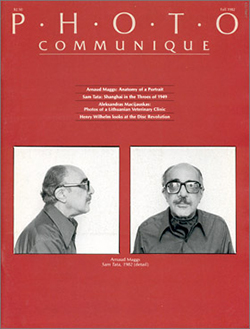1982 – Manitoba Juried Photography Exhibition
“To expect an art to mature in six years,” writes James Borcoman in one of the jurors’ statements that prefaces the1982 Manitoba Juried Photography Exhibition catalogue, “is to be hopeful beyond reason. But if photography in Manitoba has not fulfilled the larger expectations between the first Manitoba Juried Exhibition in 1976 and this second one in 1982,” he continues, “nevertheless it has reached a level of competence and self-confidence that suggests a vigorous maturity happily waiting around the corner.”
This seems like a fair assessment. The 1982 Manitoba exhibition, which was on display at the Manitoba Archives Building Gallery during the month of May, has been reproduced in its entirety for this publication (copyright 1982 by the Winnipeg Photographers’ Group), and includes 64 images, 22 of which are in colour, by 36 photographers. While the work does not break new ground, it does display a range of talents and interests to good advantage: generally speaking the photographs are current, stylistically aware, and technically skilled, and in some cases considerably more. Images worth particular mention would include Hersh Gutwilik’s “Dead Sea, Israel” (p. 28), John Hays’ flash-and-available light landscapes (pp. 30 and 31), Bruce Kirton’s finely balanced laundry-room still life (p. 42), Richard Skinder’s “Kitsilano Pool, Vancouver” (p. 48), Marie May’s untitled portrait (p. 53), and Debra Mosher’s tightly-framed, harshly lit head shots (pp. 59-61).
So in terms of overall quality and some exceptional images, the catalogue comes across well. Its weak point lies in the fact that most of the work falls into fairly standard photographic categories: urban or suburban landscape (13 images), man-altered landscape (7 images), street photography or grab shots (7 images), and many interiors, both populated and unpopulated (9 images). The same is true for technique: we see black and white, colour, hand colour, direct flash, flash fill with slow shutter speed, one assembled panorama, a few deliberately shifted horizons or camera positions, and so on. But there is a real scarcity of original or involving portraiture, and a complete absence of fantasy or conceptual imagery, multiple printing, non-silver work, Xerography, or instant-camera photography, which is surprising in a show drawn from over six hundred entries.
No group exhibition is perfect; probably all suffer to some degree from biases introduced in the selection and editing process. A viewer has no real way of knowing what the pictures that did not get accepted for the 1982 Manitoba Juried Exhibition might say about the breadth and scope of current photography in Manitoba, but one hopes there is more activity in some of these photographic areas than meets the eye in this one catalogue.

